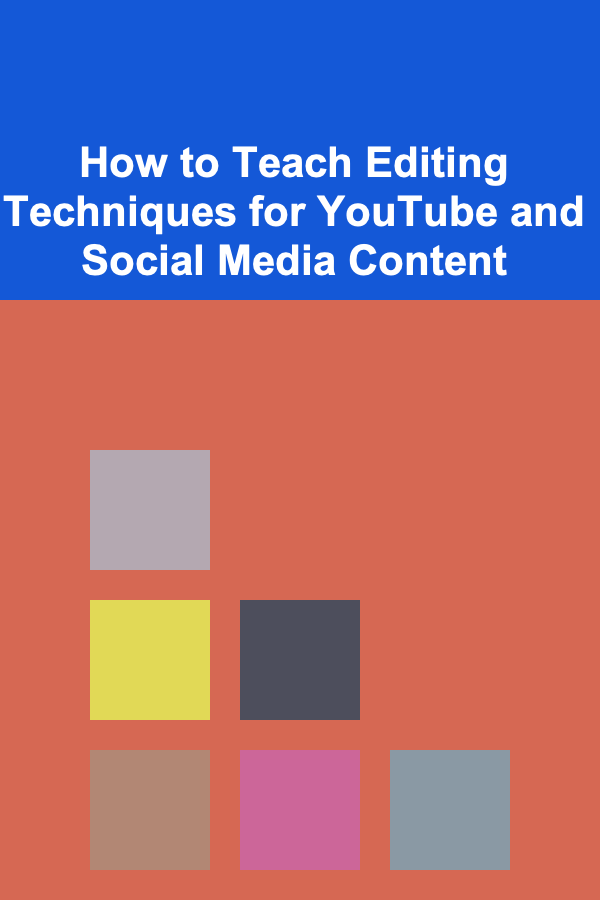
How to Teach Editing Techniques for YouTube and Social Media Content
ebook include PDF & Audio bundle (Micro Guide)
$12.99$11.99
Limited Time Offer! Order within the next:

Content creation for YouTube and social media has evolved beyond simple shooting and uploading. High-quality editing is now a fundamental skill for any creator aiming to stand out in a crowded digital space. Editing doesn't just refine the visual and audio elements of a video, but it also elevates the storytelling, pacing, and emotional impact of the content. Whether you're training someone to become an expert editor or you're just beginning to learn the ropes yourself, understanding the essential techniques of video editing for platforms like YouTube and social media can make a significant difference in the effectiveness of your content.
This guide provides a comprehensive approach to teaching video editing, tailored specifically for YouTube and social media. It covers everything from the basic principles of editing to advanced techniques used by seasoned professionals.
Understanding the Basics of Video Editing
Before diving into specific techniques, it's crucial to start with the fundamentals. Every successful video editing session begins with a strong foundation of knowledge.
1. Understanding the Platform's Demands
Every platform has its own set of preferences when it comes to video length, aspect ratio, resolution, and style. While YouTube videos often allow for longer, more detailed content, social media platforms like Instagram, TikTok, and Facebook favor shorter, punchier videos with a clear hook in the first few seconds.
As an editor, your first task is to understand the platform you're editing for and adjust accordingly. For example:
- YouTube: A typical video may range from 5 to 15 minutes. Longer-form content may require tighter pacing, engaging transitions, and dynamic cuts to maintain viewer interest.
- Instagram & TikTok: Content is short, often under 60 seconds, so every second counts. Fast-paced editing with sharp transitions and compelling hooks is key.
2. Introduce the Concept of Storytelling
Every video, no matter the length, should tell a story. Good storytelling doesn't just rely on what's being shown, but how it's shown. Every shot and cut should serve a purpose to advance the narrative.
When teaching editing, stress the importance of the following:
- Beginning, Middle, End: Every video should have a clear structure. The opening should hook the viewer, the middle should provide value or entertainment, and the ending should either provide a resolution or a call to action.
- Pacing: Adjust the pacing to match the mood and content of the video. A fast-paced action sequence might require rapid cuts, while a reflective moment might benefit from lingering shots.
3. Selecting the Right Software
While advanced editors may use professional software like Adobe Premiere Pro or Final Cut Pro , beginners might start with easier-to-use tools like iMovie , Filmora , or even Canva for basic social media posts. The key is to choose software that allows for flexibility and growth as you refine your skills. When teaching editing, start with simple programs to build confidence and gradually introduce more complex features.
Core Editing Techniques
Once the basics are covered, it's time to dive into practical editing techniques that are essential for YouTube and social media content.
1. Cutting and Trimming
Cutting and trimming are the most fundamental editing techniques. Instruct your students or learners to focus on trimming unnecessary clips and ensuring that the final product flows seamlessly. For YouTube content, aim for a balance between keeping viewers engaged and not overwhelming them with too much content.
- Jump Cuts: These are rapid cuts that eliminate the boring parts and help maintain viewer attention. These are particularly useful for YouTube creators who want to streamline their dialogue-heavy videos.
- Cutting on Action: In action-packed videos, teach the importance of cutting on action. Cutting at the peak of a movement or emotion keeps the energy high and the viewer's interest locked in.
2. Transitions and Effects
Transitions smooth the shift from one scene to the next. However, transitions should be used thoughtfully. They can either enhance the storytelling or distract from it if overdone.
- Simple Cuts: The most effective transitions are often the simplest. Teach that cuts between scenes or ideas without fancy effects often feel the most natural.
- Creative Transitions: For social media content, creative transitions are widely used to grab attention. For instance, the "whip pan" (a quick horizontal camera motion) is popular in TikTok and Instagram Reels for its energetic vibe.
- Match Cuts: These are cuts that match the action between two shots, creating a fluid and visually appealing transition.
3. Color Grading and Correction
Color correction is crucial to ensure that the colors of your footage appear consistent, while color grading is the process of giving your video a stylistic, artistic feel.
- White Balance: Ensure the white balance is correct. If the video footage looks too warm (yellow/orange) or too cold (blue), it can distract the viewer. The goal is to make the video look natural.
- Color Grading: Teach the importance of color grading to give the video a unique feel. Many YouTube creators use warm tones for a cozy feel or cool tones for a sleek, modern vibe.
4. Sound Design
Great video editing isn't just about the visuals; sound design plays an equally important role. From music and voiceovers to sound effects, audio can elevate a video and make it more immersive.
- Background Music: Teach how to add background music that matches the mood of the video. Ensure that the music doesn't overpower dialogue or other important audio.
- Sound Effects: On platforms like TikTok and Instagram, sound effects can make a significant impact. Show how to use them to punctuate key moments and add emphasis to specific actions.
- Voiceovers: Voiceovers can add personality or provide explanations for YouTube tutorials, for example. Teach how to layer voiceovers in a way that doesn't clash with the background music or primary audio.
5. Text and Graphics
Text overlays and graphics can significantly enhance the user experience, especially on social media platforms. Adding captions, lower thirds, and titles can help convey information quickly and keep the audience engaged.
- Subtitles: On platforms like YouTube, many viewers watch videos with the sound off, so it's essential to add subtitles to ensure your message is still conveyed. Teach how to time subtitles correctly.
- Animated Text: In social media content, animated text can quickly grab attention. Instruct on how to use kinetic typography (moving text) to highlight important points or make a visual impact.
6. Using B-Roll
B-Roll refers to supplementary footage used to support the main story. For YouTube and social media creators, incorporating B-roll can make the content feel more polished and professional.
- Cutting to B-Roll: When teaching editing, show how to use B-roll to cover jump cuts or to provide visual context to the narrative. For example, in a cooking video, cut to close-ups of ingredients as the host explains the recipe.
- Creative B-Roll: Teach how to use creative B-roll that complements the tone of the video. In a lifestyle vlog, for instance, you can use nature shots, cityscapes, or personal clips to enhance the storytelling.
7. Optimization for Social Media
Editing for social media requires an understanding of platform-specific features and requirements. For instance:
- Aspect Ratio: Videos for Instagram stories or TikTok should be vertical (9:16), while YouTube typically uses a horizontal (16:9) aspect ratio.
- Aspect Cropping: You may need to crop your footage to fit the platform's preferred dimensions without losing key visual information. Show how to adjust framing so that important elements remain visible.
8. Exporting the Video
Finally, once the editing is complete, exporting is a crucial step. Instruct on how to export videos in the best formats for each platform:
- YouTube: Export in high-definition (1080p or higher) and choose MP4 as the video format.
- Social Media: Optimize file sizes for faster uploads, but ensure the video maintains good quality. Instagram may require square (1:1) or vertical (9:16) formats, while Facebook prefers 16:9.
Advanced Editing Tips for Experienced Creators
Once the basics are mastered, teaching advanced editing techniques can take a creator's content to the next level.
1. Multicam Editing
For creators with multiple camera angles, multicam editing allows for smoother transitions between angles. This technique is particularly useful for interviews, live events, or tutorial videos.
2. Motion Graphics
Motion graphics are often used for intros, outros, or special effects. Teaching tools like Adobe After Effects can give your learners the skills to create impressive graphics and animations to elevate their brand.
3. Slow Motion and Time-Lapse
These techniques can add visual interest to a video. Show how to shoot at high frame rates for slow motion and teach how to speed up footage for time-lapse.
4. Green Screen Editing (Chroma Key)
Using green screen (chroma key) techniques allows creators to replace the background with anything they choose. This opens up endless creative possibilities, especially for YouTube creators who want to insert themselves into different environments.
Conclusion
Editing is both an art and a technical skill. To teach effective editing techniques for YouTube and social media, it's essential to blend creativity with technical expertise. By mastering the basics of editing, understanding platform-specific needs, and learning advanced techniques, you can help new editors create content that not only looks professional but also resonates with their audience. With practice and experimentation, anyone can become proficient in video editing and take their content to new heights.

How to Design an Elegant and Understated Holiday Dining Room
Read More
How to Optimize Routes for Faster and Cheaper Deliveries
Read More
How to Organize a Family Talent Show with DIY Costumes
Read More
How to Use Window Sensors for Enhanced Home Security
Read More
How To Understand the Basics of Black Holes
Read More
How to Manage Risk and Disruptions in Global Supply Chains
Read MoreOther Products

How to Design an Elegant and Understated Holiday Dining Room
Read More
How to Optimize Routes for Faster and Cheaper Deliveries
Read More
How to Organize a Family Talent Show with DIY Costumes
Read More
How to Use Window Sensors for Enhanced Home Security
Read More
How To Understand the Basics of Black Holes
Read More